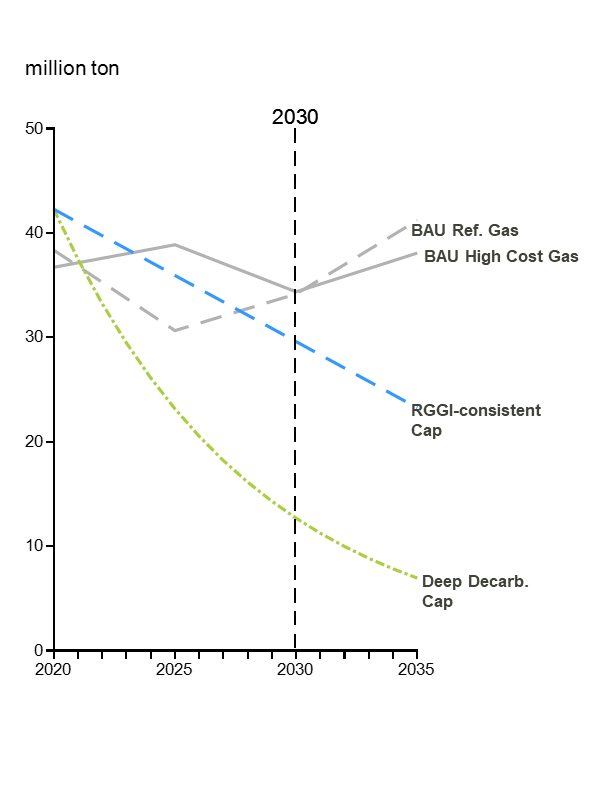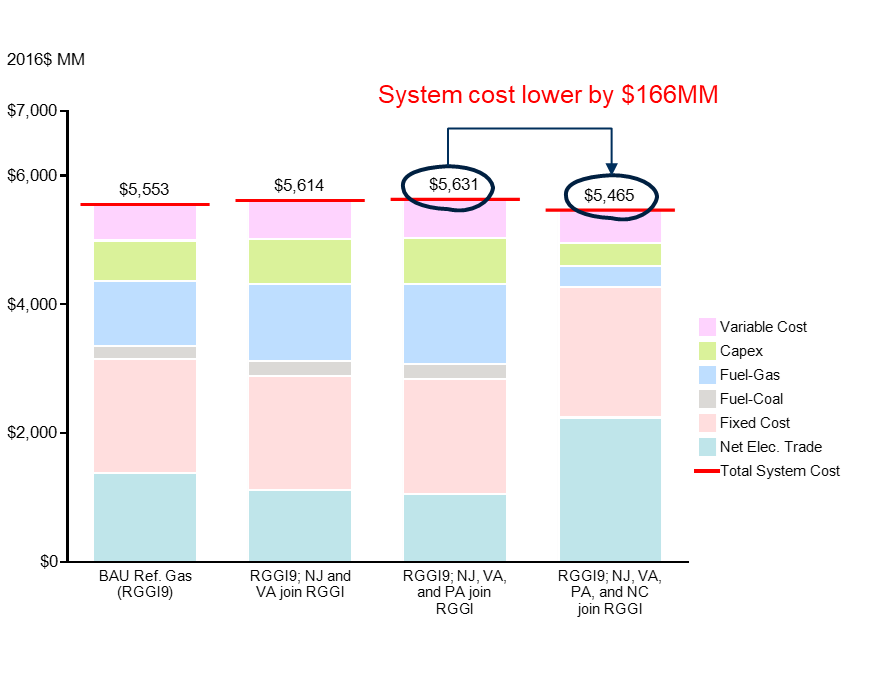As North Carolina Governor Cooper considers policies to reach the state’s climate goals, analysis from EDF and M.J. Bradley & Associates shows that joining the Regional Greenhouse Gas Initiative (RGGI) can help get the job done. RGGI would significantly reduce climate-warming pollution in North Carolina by capping and reducing power sector carbon emissions.
The analysis underscores that North Carolina will not reach its emission reduction targets under a business-as-usual scenario, though a strong cap on emissions can deliver the reductions necessary while driving investment in zero emitting resources. We also found that RGGI can help North Carolina reduce emissions while lowering overall system costs, reducing the state’s reliance on fossil fuels, and improving public health through reduced air pollution.
EDF and M.J. Bradley & Associates modeled the potential impacts of placing a cap on power sector emissions that declines at a rate consistent with the cap trajectory adopted by the 10 other states participating in the regional program. This analysis looked at several different scenarios, which evaluated a range of fuel prices and different options regarding whether surrounding states capped power sector emissions and found substantial benefits from participation in RGGI. The analysis was completed prior to availability of data related to potential impacts of the COVID-19 pandemic on carbon emissions, electricity demand, and economic recovery, though COVID-19 considerations are addressed below.
By modeling a range of fuel price and policy scenarios, we can draw useful insights about expected trends in emissions, electricity generation sources, and power sector costs based on a number of different factors. Energy models, like the one used in this analysis, are not crystal balls that predict exactly what emissions or costs will be in the future, but they provide useful insights about the directional impacts of climate policies compared to a business-as-usual (BAU) scenario with no carbon limit.
What is RGGI?
RGGI is a collaboration of 10 Northeast and Mid-Atlantic states that is designed to lower pollution by placing a declining limit and a cost on carbon emissions from the power sector. Many businesses, environmental groups, and the public support placing a limit on carbon as a necessary and effective way to address climate pollution from electricity generation.
At minimum, meeting the emission targets established by Governor Cooper’s Executive Order and the state’s Clean Energy Plan is necessary to have a chance at averting the worst impacts of climate change. Already, North Carolina is seeing rising temperatures, more extreme weather, rising sea levels and risks to public health caused by air pollution from fossil fuel plants. Electricity use is the largest contributor of carbon pollution in North Carolina based on its most recent greenhouse gas inventory, so it is crucial for the state to address these emissions. Reducing emissions from the electric power sector also facilitates decarbonization of transportation and buildings through electrification.
RGGI offers a flexible framework to reduce emissions from electricity generation at low cost which if well-designed, can address the unique needs of the state’s communities. Since pollution from power plants disproportionately impacts low-income communities and communities of color, the state can identify what safeguards and complementary policies can drive localized pollution reductions in its most overburdened communities. North Carolina can also develop a strategic investment portfolio that directs RGGI proceeds where they are most needed, including initiatives that invest in energy efficiency, renewable energy and clean transportation options that reduce pollution in overburdened communities.
Key findings from the analysis
1. Short term emission reductions achieved by transitioning from coal to natural gas generation are not enough to meet North Carolina’s climate goals.
Under business-as-usual, power sector emissions in North Carolina will not decrease to levels consistent with the state’s goals, according to the analysis. Emissions are expected to fall in the near term as the state retires or converts many of its currently operating coal plants and replaces that electricity with more natural gas. However, as our modeling shows, these near-term emission reductions will not persist as growing electricity demand is met by burning more natural gas.
Natural gas still emits climate warming carbon dioxide (CO2), and the extraction and transportation of the fuel releases significant amounts of methane (CH4) into the atmosphere during. Natural gas combustion also produces health-harming co-pollutants, like volatile organic compounds, nitrogen oxides, and various forms of hazardous air pollutants, that affect surrounding communities. North Carolina cannot reach its net-zero emission target or eliminate dangerous air pollution from power plants by relying solely on natural gas.
Electric Power Sector CO2 Emissions in North Carolina
 2. A cap on emissions reduces pollution well below business-as-usual and incentivizes clean energy investment.
2. A cap on emissions reduces pollution well below business-as-usual and incentivizes clean energy investment.
The models show that a RGGI-consistent cap (i.e. a limit on carbon pollution) would reduce greenhouse gas emissions well below the business-as-usual scenario, protecting against longer-term emissions increases by encouraging and accelerating investment in zero emitting sources. Participation in RGGI will bring North Carolina much closer to its climate goals and a decarbonized power sector as quickly as possible, which will not be achieved under business-as-usual.
Moreover, placing a limit and a price on carbon pollution would provide support to renewable energy investments and to North Carolina’s existing zero-emission nuclear generation by making them more economically competitive with fossil fuel sources. The analysis shows that RGGI would enable approximately 80% of the state’s current nuclear generation to remain economically competitive in 2030 by ensuring that fossil generators have to pay a compliance cost associated with their carbon emissions. The retention of these existing assets is nearly double what would be expected under business-as-usual. Supporting the existing nuclear fleet provides resilience for these assets and the jobs they support under a range of possible futures, including one in which the state moves to a competitive wholesale market.
3. A carbon limit in North Carolina would reduce carbon emissions across the region.
By capping North Carolina’s power sector climate pollution, annual emissions in the Eastern Interconnect would be roughly 21 million tons lower in 2030 compared to the business-as-usual scenario, according to our analysis. Even with slight shifts in power generation between states in the region that might result from a RGGI rule, the overall emissions from the region in total are expected to fall with the cap in place.
This result demonstrates that while some leakage – the shifting of emissions out of state due to increased electricity imports – may occur, it does not outweigh the benefits of the program. Overall emissions from the region are substantially lower than BAU levels. An effective leakage mitigation mechanism, like placing emissions associated with imported electricity under the cap, can achieve even greater regional reductions.
4. North Carolina can reduce emissions cost-effectively, save ratepayers money and boost the economy.
Since RGGI keeps costs low by allowing companies to implement the most cost-effective measures to achieve emission reductions, total utility system costs in North Carolina could be $166 million lower in 2030 compared to the scenario where the state does not join RGGI.
North Carolina System Costs in 2030
While our analysis did not look specifically at macroeconomic impacts or evaluate potential reinvestment portfolios for allowance proceeds, we know from experience that RGGI produces significant economic benefits to states.
Other studies have shown that by driving investments in energy efficiency, RGGI has already reduced consumer energy bills, boosted the economy and produced enormous public health benefits. By encouraging the growth of cleaner electricity sources, RGGI has reduced air pollution, which has helped save hundreds of lives, prevented thousands of asthma attacks and saved billions of dollars in health-related economic costs across the Northeast
Electricity bill modeling by the Analysis Group found that the average residential electricity bill in RGGI states will be 35%t lower in 2031 than it is today, due in part to investments in energy efficiency – an approach North Carolina can follow to yield benefits for its own ratepayers.
Implications of the COVID-19 pandemic
A recent analysis from Rhodium Group demonstrates that the COVID-19 pandemic has weakened electricity demand and emissions have accordingly declined, a trend expected to continue through the mid-2020s before reductions flatten. Coal-fired generation was expected to further decline due to its lack of economic competitiveness with more cost-effective, clean sources, and COVID-19 amplifies this trend. However, Rhodium notes that “COVID-19 will leave a legacy of a more carbon intensive economy compared to our pre-COVID baseline without additional policy action.”
While the impacts of COVID-19 lower emissions, they reduce economic output even more, which means we are becoming more carbon intensive – emitting more pollution per unit of GDP. Further, early signs of recovery indicate that energy demand and emissions are already returning to pre-pandemic levels. Without additional steps to reduce the carbon intensity of our economy, carbon emissions and the impacts of climate change will become even more disruptive in the future.
An opportunity for North Carolina
By joining RGGI, North Carolina can continue to reduce carbon emissions and improve air quality in the state, while stimulating economic growth through investments in cleaner energy resources.
RGGI is a critical tool for revitalizing the economy in the wake of the COVID-19 pandemic and for making progress on the governor’s climate goals. It also offers North Carolina the flexibility to design a program that directs both economic and air quality benefits to the communities that have been the most overburdened by pollution.
Read more about the benefits of the Regional Greenhouse Gas Initiative (RGGI) in this fact sheet.











One Comment
Emission reductions – The numbers in the graph and the dialogue don’t seem to match. Graph shows 30% reduction for REGGI at 2030 (43 to 30 = 13 million tons reduction). #3 says 21 MT.
What electricity model was used in creating this report?
Is the BAU case similar to the BAU case used by Duke Energy in its 2020 IRP?